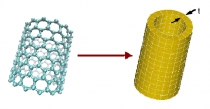Deduction of Mechanical Properties of Carbon Nanotubes from Molecular Statics/Dynamics Simulations
Dr. R. C. Batra
Department of Engineering Science and Mechanics
Virginia Polytechnic Institute and State University Blacksburg, VA
My research group has used molecular statics simulations of single-walled carbon nanotubes (SWCNTs) deformed in simple tension/compression, shear, uniform radial expansion to deduce their mechanical properties. Assuming that the energy required to deform a SWCNT equals that need to deform an equivalent continuum structure by the same amount, we have found the wall thickness the mechanical properties such as Young’s modulus, the shear modulus, and Poisson’s ratio of a SWCNT. These values have been used to study buckling due to axial compression of a SWCNT, a double-walled and a triple-walled carbon nanotube. The buckling mode of a triple-walled carbon nanotube seems to be different from that of an equivalent continuum structure.

(Left) Single-wall carbon nanotube (SWCNT); (right) equivalent continuum structure of SWCNT. References: Physical Review B, 69, Art. No. 235406, 2004; Physical Review B, 73, Art. No. 085410, 2006.
We have also studied free vibrations of a SWCNT with no forces applied at ends of the tube. Requiring that frequencies and mode shapes of vibrations of a SWCNT match with those of an equivalent continuum structure also gives values of the wall thickness and the mechanical properties. These are found to differ from those determined from molecular statics simulations described above. Furthermore, frequencies of the inextensional modes of vibration of (n,0) zig-zag SWCNTs found through molecular mechanics simulations are found to saturate as the circumferential half wavelengths approaches (n-1)/2 or n/2 according as n is odd or even. However, this saturation of frequencies does not occur for a continuum tube.
Biosketch
Romesh Batra is the Clifton C. Garvin Professor of Engineering Science and Mechanics at Virginia Tech. He earned his Ph.D. from the Johns Hopkins University. The work of his group has been recognized by his peers who selected him for the Alexander von Humboldt Award (1992), the Society of Engineering Science Medal (2009), State Council of Higher Education of Virginia Outstanding Faculty Award (2010), listing in the ISI Highly Cited Authors (2010), and the Virginia Outstanding Award (2011).

